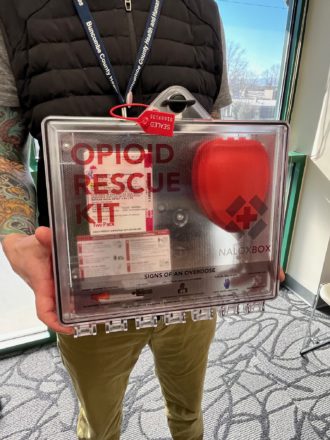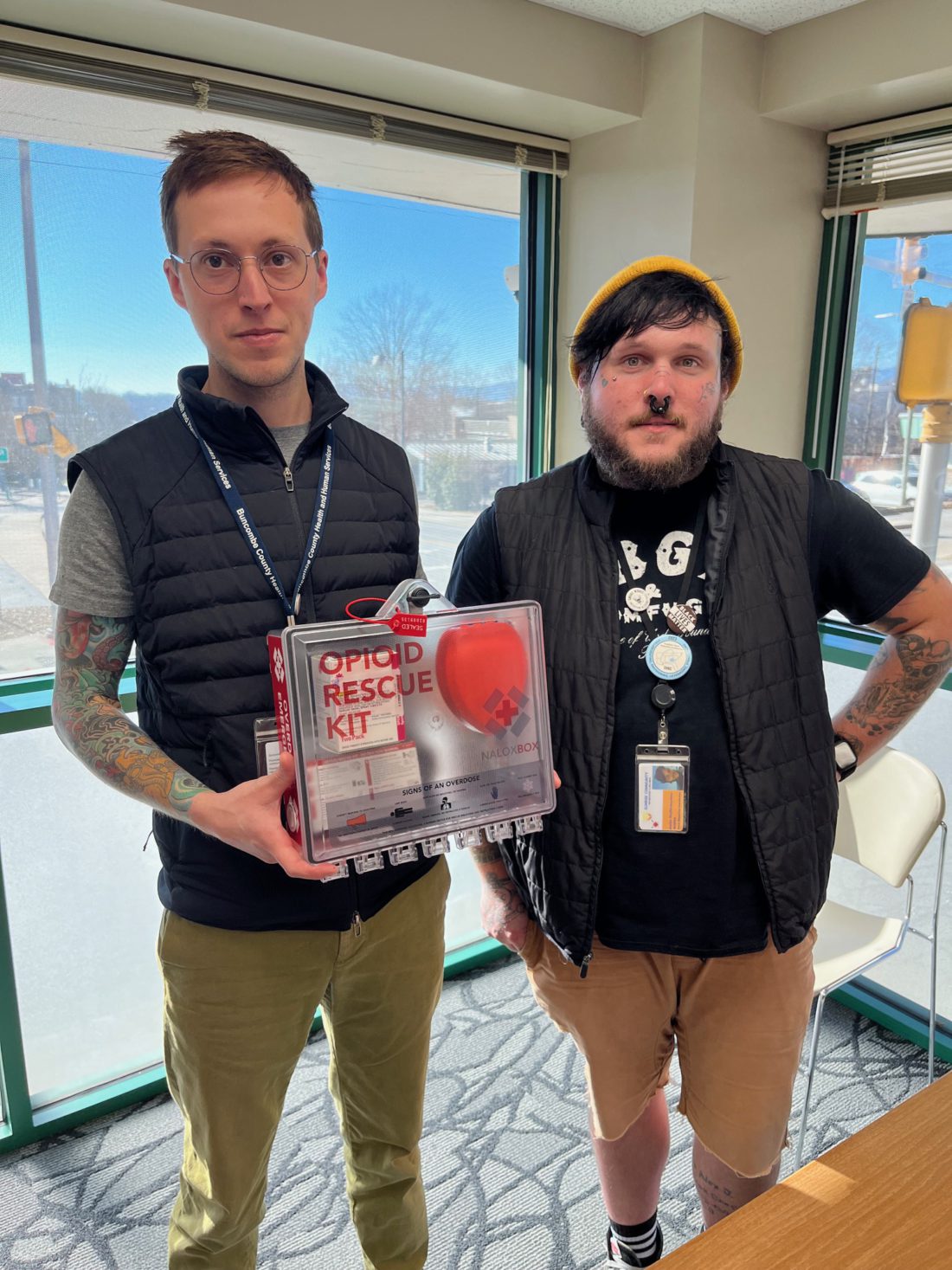Medication-assisted treatment. Training on how to administer Narcan. Education and stigma reduction. These are just a few of the initiatives funded by Buncombe County’s opioid settlement money to address the local impact of the opioid crisis.
North Carolina state and local governments will receive $1.5 billion in settlement funding from pain medication manufacturers and sellers, staggered in annual payments between 2022 and 2038. Buncombe County is slated to receive a total of $29,353,031 during the 17-year period.
County officials understand that the crisis is larger and more complex than the misuse of prescription opioids, says Buncombe County Commissioner Jasmine Beach-Ferrera. She was the county’s liaison to the state’s opioid settlement work group.
Polysubstance abuse — when more than one drug contributes to an overdose — is an emergent problem. For example, fentanyl is an opioid that is 50 times stronger than heroin. It can be cheaply made and therefore is used as a filler in other drugs. Fentanyl has been identified in the local drug supply since 2015, according to the county’s Opioid Settlement Strategic Planning Report, which was published in May. That year, 33% of overdoses among Buncombe County residents involved fentanyl. By 2021, that percentage rose to 74%.
“At a big-picture level, Buncombe County is arguably a pacesetter in the state and arguably in the country for trying to develop responses to the crisis we already understand, and then the emerging crises related specifically to the high risks of polysubstance users are experiencing because of the ubiquity of fentanyl,” Beach-Ferrera explains.
Polysubstance overdose deaths accounted for 10% of all overdose deaths among Buncombe County residents in 2015, according to the county’s report. In 2021, they composed 50% of such deaths.
Beach-Ferrera adds that the county is also on top of “emerging local trends on disproportionate impact on BIPOC communities, as well, when you look at death rates.” County data shows 3% of all overdose deaths in 2015 were among people of color. By 2021, overdoses in this demographic increased to 13% of all overdose deaths.
Decreasing overdoses
Buncombe County is focusing efforts on decreasing overdose deaths, says Beach-Ferrera. More county residents died from an overdose in 2021 than any other year on record, according to the county’s report.
Increased access to naloxone, a medication that can reverse the effects of opioid overdose, is one of the county’s primary strategies to decrease these deaths, according to the county report. Naloxone can be administered as a nasal spray, commonly known by its brand name Narcan, or as a shot in the thigh.
In June, Buncombe County began offering a monthly free overdose reversal training to members of the public at the Health and Human Services Building. Participants learn how to prevent and respond to opioid overdoses and receive one free Narcan nasal spray kit.
Local nonprofits are key for dispersing the lifesaving medication as well. Sunrise Community for Recovery and Wellness has given out 2,500 doses of naloxone since July, says harm reduction coordinator Justin Shytle.
NaloxBoxes are another method to increase access to the overdose reversal medication for bystanders. A NaloxBox is a large plastic box containing two doses of Narcan, a CPR face mask shield and five-step instructions on how to administer Narcan. It can be mounted on a wall — similar to a fire extinguisher or an automated external defibrillator — and it’s opened via a simple breakaway tag.
Buncombe County purchased 100 NaloxBoxes and has installed 33 so far in the community, according to BCHHS harm reduction program manager Mitchell Albers. Some local music venues, as well as homeless shelters and other locations, installed these free boxes. (Naloxone can be damaged at temperatures over 104 degrees, and therefore NaloxBoxes can’t be installed at outdoors locations like parks, Albers explains.)

The county also installed a NaloxBox at all 12 branches of the Buncombe County Public Libraries in September, says Director Jason Hyatt. Library staff received training about the NaloxBox and how to administer naloxone from BCHHS.
“Thankfully, we have not had to make significant usage of them,” Hyatt continues. But he was aware of one incident at a library where a patron determined someone was overdosing, obtained Narcan from the NaloxBox and administered it while library staff called emergency services. That is “the ideal scenario,” he says. “Somebody being able to help somebody else out and having the resources [to do so].”
In addition to supplying medication, Albers says another goal for NaloxBoxes is for naloxone to be seen as just another emergency tool, like a fire extinguisher, a defibrillator or an EpiPen. Hyatt agrees that NaloxBoxes are an opportunity to educate the public about strategies to reduce deaths from opioid overdoses and perhaps reduce stigma around substance use disorder.
“I’ve noticed patrons, staff and other folks who’ve stopped and been curious [about the NaloxBox] after it was first installed,” Hyatt says. “And since there is information on the box itself about the signs to look for opioid overdose, it feels like an education effort as well. It ticks all the boxes for us.”
Community paramedicine
Another key component for addressing the local opioid crisis is expansion of the community paramedicine program within the Buncombe County Emergency Services Department. The post-overdose response team, or PORT, follows up with patients after an overdose and links them to further care, which can range from supplying naloxone or fentanyl test kits to making connections to medication-assisted treatment.
PORT started as a pilot in 2020 and debuted in 2021 as a six-person team. There are now three teams and a supervisor, explains Shuchin Shukla, Buncombe County medical substance use professional, who is board-certified in addiction medicine.
In March 2022, the PORT began starting patients on medication assisted treatment, or MAT, which is an evidence-based treatment for opioid use disorder, according to the national Centers for Disease Control and Prevention. MAT involves taking a medication to address withdrawals, like buprenorphine or methadone, while also undergoing counseling to address the addiction.
The PORT can administer MAT for several days until the patient gets an appointment with a medical provider at Mountain Area Health Education Center who can then take the patient under care and prescribe the medication. (Shukla helped develop the MAT pilot when he previously worked for MAHEC.)
“It’s really amazing that our community paramedic program has been funded,” Shukla says. “And not just with [opioid] litigation dollars but the county budget, to really meet the needs of a community that’s having worsening issues related to being unhoused and having substance use disorders.”
Planning for the long term
Buncombe County behavioral health manager Victoria Reichard says the county is being strategic about settlement money expenditures. Some funding will address acute needs that arise during the 17-year payout period, Reichard explains. For example, should a new substance enter the drug supply — the way that fentanyl has — it could require an unforeseen, specific intervention, and the community could respond to it in real time.
The county also isn’t spending all the settlement funds once they hit its bank account. According to the N.C. Opioids Settlements dashboard, the county received $2,097,004 during the last fiscal year. But Reichard says the county spent only $352,612 of that.
During fiscal year 2023-24, Buncombe County is set to receive $4,121,738, according to the dashboard. (As of Jan. 1, it received $1,209,123.70 of the payment expected this year, Reichard says.) However, the county has budgeted to spend only $2,711,995 of the 2023-24 funds.
The surpluses are being held by the county to be used in the future to sustain services the county is planning in the long term, explains Reichard. Some funding will be used to establish solid ground for long-term projects, she explains. In the Opioid Planning Strategic Settlement report, support for recovery housing and recovery-friendly workplaces, among others, are some of the long-term projects cited. Surplus funds aren’t lost if they aren’t used immediately, and they accrue interest, Reichard says.
The City of Asheville is also receiving a slice of the state’s settlement fund pie: It has a total of $2,755,976 coming during the 17-year settlement period, and so far received $196,886 during 2022-23. The city is expected to receive $386,993 during 2023-24.



Before you comment
The comments section is here to provide a platform for civil dialogue on the issues we face together as a local community. Xpress is committed to offering this platform for all voices, but when the tone of the discussion gets nasty or strays off topic, we believe many people choose not to participate. Xpress editors are determined to moderate comments to ensure a constructive interchange is maintained. All comments judged not to be in keeping with the spirit of civil discourse will be removed and repeat violators will be banned. See here for our terms of service. Thank you for being part of this effort to promote respectful discussion.